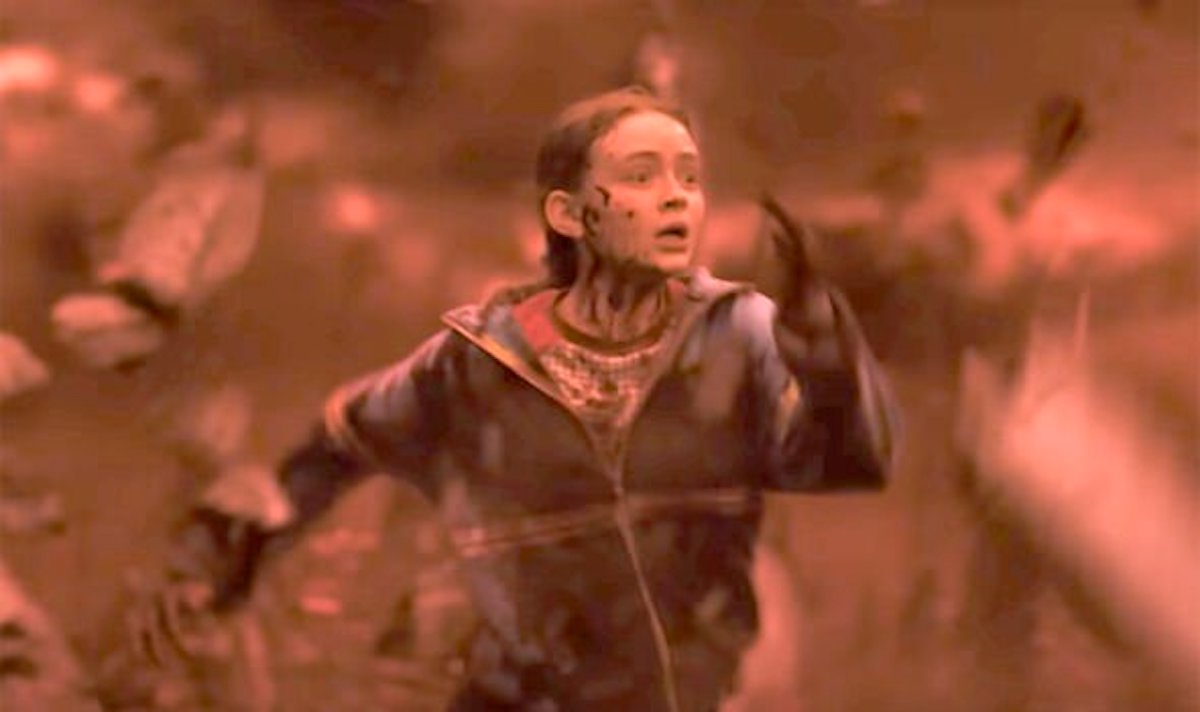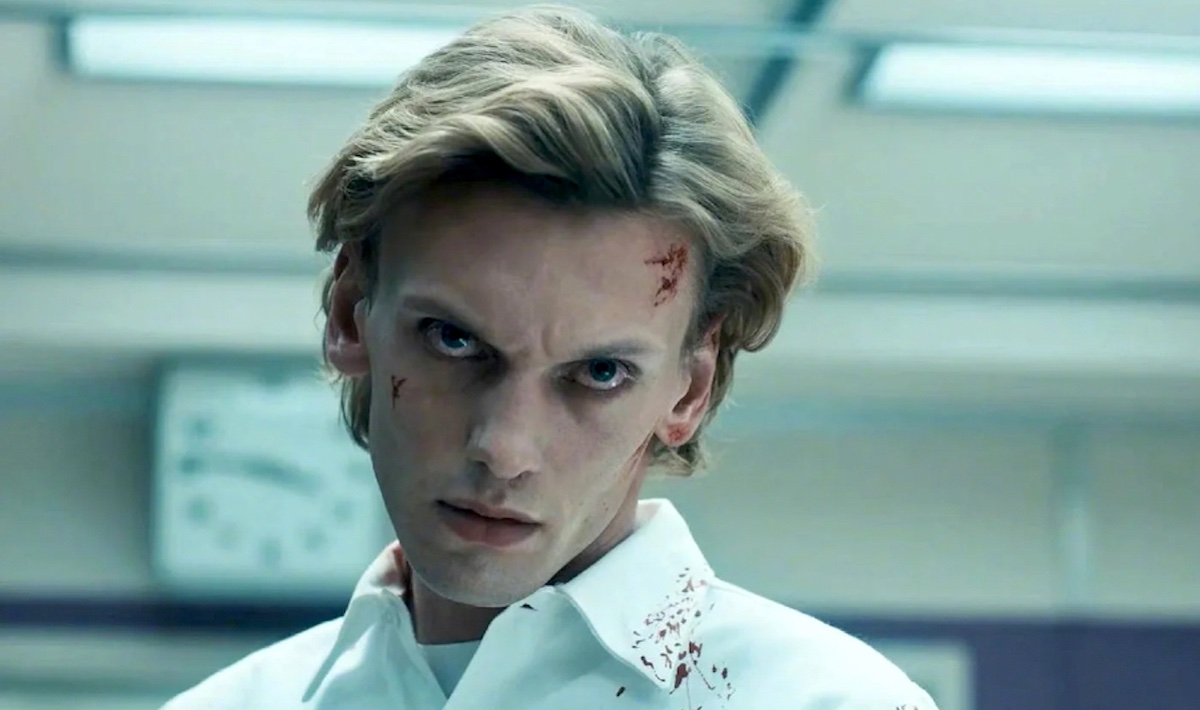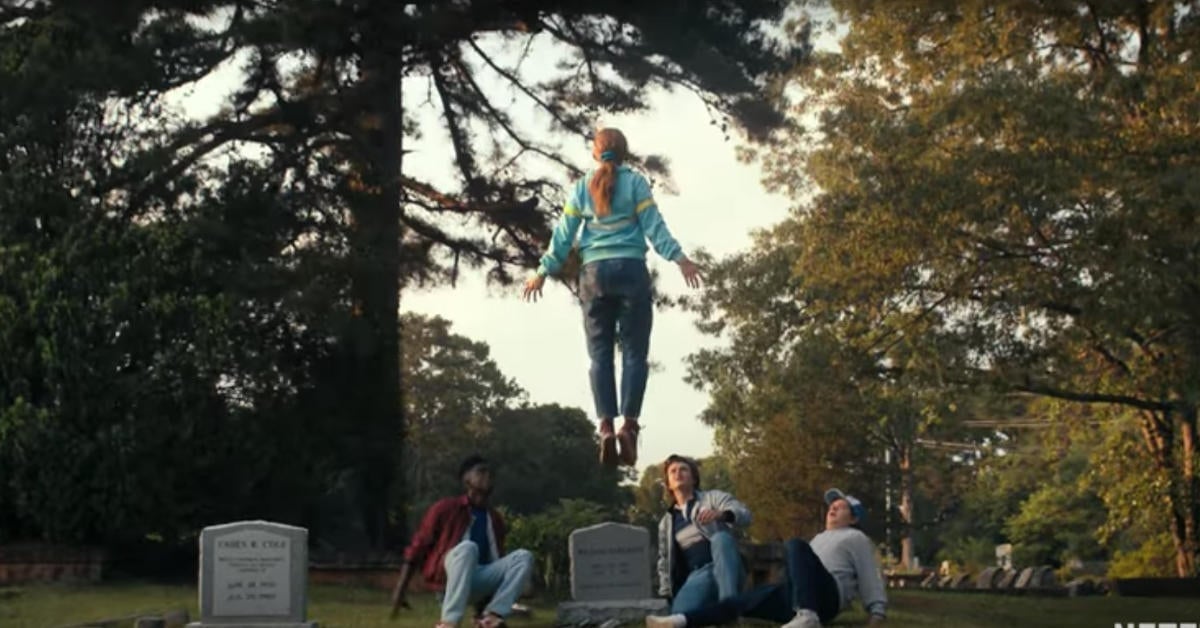When Volume 1 of Stranger Things 4 came out on the same week of the horrific shooting in Uvalde, Texas, Googling the question, “Is Stranger Things 4 triggering?,” rightly yielded warnings about the season’s opening scene. The Netflix show even added a content warning disclaimer ahead of the first episode, which shows the brutal massacre of children at Hawkins lab. But there was another reason Stranger Things 4 could be triggering: its no-nonsense depiction of both active traumatic situations and post-traumatic stress disorder (PTSD), and the fates which befall the characters who are suffering from either.
I, for one, almost quit Stranger Things 4 in the middle of the first episode. And not because of the graphically slaughtered children, though that was obviously upsetting (for real, Netflix: you could’ve delayed the release a week and re-edited that). I almost stopped because of the scene where Chrissy has a hallucination in a bathroom stall of her mother screaming at her and violently shaking the door. This flavor of Mom Stuff, for me, hit very close to home. I had to pause the episode. Suffice it to say, Chrissy’s eventual fate wasn’t exactly comforting.
I have PTSD, and I personally can’t watch Stranger Things 4 from any other lens. And because I typically experience media by latching onto a character, I grew to feel a deep attachment to Max Mayfield. I’m not going to pretend I can journalistically separate myself from all that for the sake of criticism, because I can’t.
Stranger Things 4 gives those of us with mental illness a lot to chew on. After all, Vecna chooses his victims because they have been traumatized. Our own Kaila Hale-Stern has written about how this “fucking sucks.” Personally, I think it was the kind of bold decision that, if handled well, could be not only justified, but empowering and healing for those who identify with characters like Max and Chrissy. If handled poorly, then the Duffer Brothers have taken a vulnerable section of their gigantic audience and baited us, only to deliver yet another “whoops, too bad!” signal from pop culture and society.
Stranger Things 4 bringing trauma as a central theme is not inconsequential. There’s a deficit of media which talks candidly, empathetically, and extensively about trauma—the two other examples springing to my mind are Steven Universe Future and One Piece. Plus, we’re still feeling the aftermath of COVID-19 quarantine, which countless people—myself included—utilized to meaningfully dig into their trauma or mental illness for the first time. That group is still quite raw. These things don’t heal quickly.
So, watching Stranger Things 4 from a place of empathy and vulnerability, one of the traumatized characters I was identifying with “making it out” became key. Yes, it’s a horror series. “No one is safe!” I get it. But I’d say if you’re going to spin your season on an axis that a vulnerable population will latch on, the idea of even just one of these victims “making it out” becomes important. Mental illness makes shit bleak. Stranger Things 4 clearly understands that. So if you’re going to show us the deepest caverns of our darkness, in detail and at length, show us some light as well.
At the end of Episode 6, I felt that Vecna was a meaningful and deeply accurate metaphor for trauma / PTSD. I was glad that trauma was a central theme. My feelings shifted by the end of Volume 2. It feels like someone gave me a warm, empathetic, and even consequential hug, only to then kick me in the balls, hard, and run away, giggling maniacally. (I don’t personally have balls, but you get the picture.)
Volume 1: Empowerment

*spoilers for Episodes 1-6 of Stranger Things 4 below*
I was incredibly dubious about Stranger Things 4 after Chapter 1. I kept watching in the hope that the show would justify the “targeting people with trauma” device. So “Chapter 4: Dear Billy” was a biggie.
The blog Very Well Mind recently released a blog post which cites therapists in discussing how Vecna is an incredibly useful, accurate symbol for mental illness. The post mirrors a lot of my own thoughts (except for the “means of externalizing your trauma” thing—didn’t know about that, it’s a damn good tip). Vecna and the nightmarish surroundings he creates are a very potent depiction of how genuinely scary trauma / PTSD feels, in a way that I’ve never, ever seen in pop culture before. The in-your-face, live-or-death, claustrophobic nature of Vecna’s threat rings true to what trauma feels like: jumping from one unpleasant memory to the next, feeling like there’s no escape from your own mind, where the bad even has the power to taint and re-color the good, having a freaky monster right in your face.
Vecna in Chapter 4 is, arguably, the most accurate metaphor for what it’s like to live with trauma I’ve ever seen. I would use it as an aid to help to others understand. We don’t live in a culture where the nightmarish-ness of specifically childhood trauma is often discussed, depicted, or validated. (Again, thank god for Steven Universe Future.) This makes Chapter 4 really stand out. Is this jaunt of Stranger Things 4 triggering? Holy shit, yes. But I felt empowered and seen.
I cried my fucking eyes out at the end of Chapter 4. I know others who did as well. Chapter 4 meant something to many of us with mental illness. Max, who seemed doomed to succumb to the embodiment of the terrors of her trauma, was able to remember there are other things in her life, things that are worth living for. Even if the instigator for that “thing,” that consolation, is a piece of music—because what teenager struggling with mental illness doesn’t have That Song?! This reminder enables Max to recover her sense of empowerment and live. If you’re watching and have a mental illness, that can feel like some powerful shit. After the episode was over, I sobbed as I repeated Max’s final line: “I’m still here.”
And then … Chapter 6 happened. It’s perhaps the only time I’ve been miffed that a monster turned out to be human. The validity of my “Vecna as trauma” metaphor was thrown out the window. Because all of a sudden—in the words of Nandor from What We Do In the Shadows—Vecna was just some “fucking guy.” An evil, shitty, very powerful guy, yes. But guys have agendas. They are different from metaphors. I was disappointed.
Volume 2: The Kick In the Balls

*spoilers for Episodes 8 and 9 of Stranger Things 4 below*
Even though Vecna was now Henry Creel, a human man who was uglified by the Upside Down, I couldn’t let go of my trauma metaphor and parallels. It was too potent for me. Integrating Vecna, meaningful PTSD metaphor, with Henry, evil man, proved difficult. That was key for Volume 2 leaving a bad taste in my mouth. You’ll notice below I keep saying “Vecna” instead of “Henry.”
When Max said in Chapter 7 that she could still feel she was “marked” by Vecna, I did a cartoonish double-take. Yes, the idea that PTSD isn’t neatly “solved” is true to life. If you’re living with a chronic mental illness, even in a good period, there’s a feeling that you’re “marked” and could slip into a bad spell. Still, the idea that the writers of Stranger Things 4 would offer up Max for sacrifice, again, after giving her such a powerful, moving escape felt to me like they were untying a meaningful knot.
But, hey, she’s armed with knowledge now. Through practice, she’s gained a better idea of how trauma / Vecna works. It’s like the tools you gain in therapy, I thought—grounding yourself in good memories, reminding yourself that it’s your mind and these “bad thoughts” don’t control you. I wanted that messaging to follow through and for Max to be able to be her own salvation. For her to be the one “make it out.” She was the last chance for any of Vecna-Henry’s victims to do so.
Max is able to shield herself in a good memory—until Vecna invades all the same. Again, true to experience. That kind of invasion happens all the time when you’re in the throes of traumatic / depressive / anxious thought cycles. But then, even with the additional help of Eleven, Vecna-Henry is able to take an unconscious Max to his lair. Where he kills her.
“But Eleven saves her! She’s just in a coma!” you might say. To which I respond: fuck that. That’s not the point here. “But her tape player got broken!” you might protest. That wasn’t her only out, I’d say—the “good memory” shield went to shit.
The Duffer Brothers made one of the most meaningful scenes of mental illness empowerment that I can think of, then decided to revisit it and entirely backtrack the messaging it held for those identifying with Max mere episodes later. Max was the only one of Vecna’s victims who was ever even given a shot. She had a realistic box of tools in which to get the upper hand on the trauma Vecna-Henry was feeding her, and the writers decided that it didn’t matter in the end. They decided that Vecna, and therefore—by my lens—the trauma, was more powerful.
What the hell does that say to the people who identified with and felt empowered by Max in Chapter 4? Where the hell does that leave people like me, viewing Vecna through this lens, dangling?
How I Felt In The End
If you’re able to watch up until Chapter 4 and view it as a separate entity to what eventually happens, I say go for it. It’s intense and triggering, but through an unspoiled lens, it can feel cathartic and empowering.
But by the end of Chapter 8, I felt differently. If you’re going to allow at least one person to escape, like in Chapter 4, then yes. You’ve delivered empowerment. Congratulations. But if the theme of the season ends up being, “Wow, this evil man who prays on trauma is stronger than anyone! Good luck, traumatized people—nothing you can do, I guess! Unless you have literal superpowers!,” then I’m going to change my goddamn mind.
To that end: you fucked up, Duffer Brothers. Badly.
Image credit: Netflix










Published: Jul 20, 2022 01:02 pm